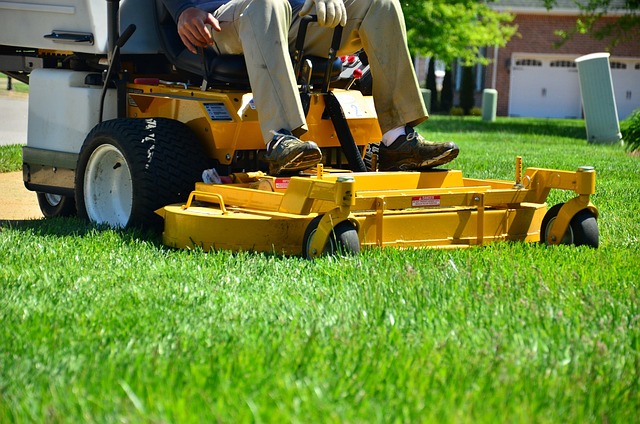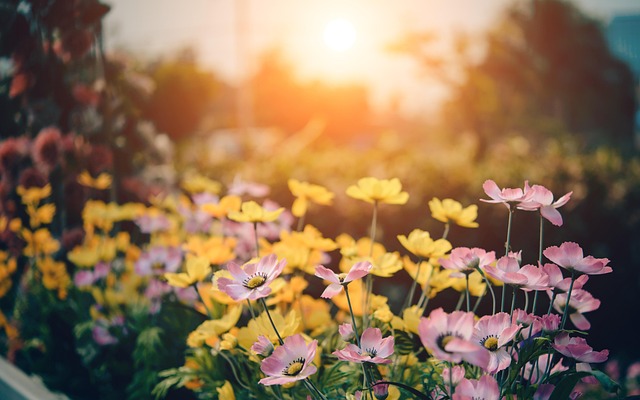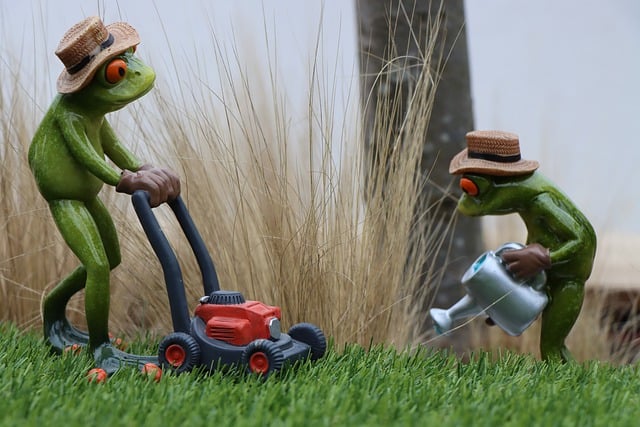Lawn care and landscaping transform outdoor spaces through strategic practices. Soil testing identifies unique lawn needs, guiding selection of balanced fertilizers for optimal growth. Weed control strategies, from pre-emergent to selective herbicides, minimize weeds while promoting lush grass. Integrating lawn care with landscaping design improves soil health, water retention, and curb appeal, creating vibrant, aesthetically pleasing outdoor environments that enhance living spaces.
Lawn fertilization and weed control are essential components of maintaining a healthy and vibrant outdoor space. In this comprehensive guide, we explore effective strategies for both lawn care and landscaping. From understanding the nuances of fertilization, including choosing the right nutrients and optimal timing, to implementing powerful yet safe weed control methods like pre-emergent and post-emergent techniques, we empower you to transform your yard into a lush, weed-free sanctuary that enhances your home’s beauty and value.
- Understanding Lawn Fertilization: Choosing the Right Nutrients and Timing
- Effective Weed Control Strategies: From Pre-Emergent to Post-Emergent Methods
- Integrating Lawn Care and Landscaping: Enhancing Your Outdoor Space's Health and Aesthetics
Understanding Lawn Fertilization: Choosing the Right Nutrients and Timing

Lawn fertilization is a crucial aspect of lawn care and landscaping, as it provides essential nutrients that promote lush growth and overall health. Understanding what and when to apply is key to achieving a vibrant, green lawn. The first step is to identify your lawn’s specific needs by conducting a soil test. This will determine the pH level and nutrient deficiencies, guiding you in selecting the right fertilizer.
Choosing the right nutrients involves balancing nitrogen, phosphorus, and potassium (NPK) levels. Nitrogen promotes lush foliage, phosphorus strengthens root growth, and potassium enhances overall health. Timing is equally important; fertilizing at the optimal time of year ensures maximum absorption and minimal environmental impact. Spring and fall are generally considered ideal seasons, as grass is actively growing, allowing for better nutrient uptake.
Effective Weed Control Strategies: From Pre-Emergent to Post-Emergent Methods

Maintaining a lush, weed-free lawn is every homeowner’s goal. Effective weed control starts with understanding different strategies. Pre-emergent methods involve applying herbicides before weeds sprout, creating a protective barrier in the soil. These are ideal for preventing annual weeds from taking hold. Post-emergent treatments, on the other hand, target already growing weeds. Selective herbicides can kill specific types of weeds while leaving grass unharmed. For broader spectrum control, non-selective herbicides can eliminate any plant they touch.
Integrating both pre and post-emergent techniques offers robust lawn care and landscaping solutions. Timing is key; pre-emergents in early spring or fall prevent summer weeds, while post-emergents handle any late bloomers. Combining these methods with proper watering, mowing, and fertilizing creates a vibrant, weed-minimal lawn that enhances any outdoor space.
Integrating Lawn Care and Landscaping: Enhancing Your Outdoor Space's Health and Aesthetics

Integrating lawn care and landscaping is a powerful strategy to transform your outdoor space into a thriving, aesthetically pleasing environment. By intertwining these two essential aspects of garden maintenance, you can achieve a harmonious balance that enhances both the health and visual appeal of your lawn and overall landscape. Lawn care involves targeted strategies to nurture the grass, manage pests, and ensure optimal growth. This includes regular mowing, watering, fertilizing, and controlling weeds. Landscaping, on the other hand, focuses on designing and arranging plants, trees, shrubs, and other elements to create a visually captivating outdoor setting.
When combined, these practices reinforce each other. Proper landscaping can provide natural barriers against weeds, encourage water retention, and offer shade, all of which contribute to healthier grass. Strategically placing plants and features like rocks or ponds can also improve soil quality and aeration, benefiting the lawn’s overall health. Additionally, a well-designed landscape enhances the curb appeal of your property, creating a welcoming and visually pleasing atmosphere that complements the lushness of your lawn.
Lawn fertilization and weed control are integral components of comprehensive lawn care and landscaping. By understanding the science behind fertilization, adopting effective weed management strategies, and integrating these practices with overall landscape design, you can transform your outdoor space into a lush, vibrant haven. Regular maintenance and an informed approach will ensure your lawn remains healthy, attractive, and low-maintenance throughout the seasons, enhancing both functionality and aesthetics for years to come.














